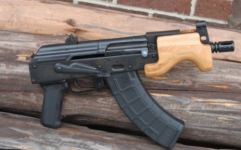The Indian Army’s ‘General Kalashnikov’ gives it a new 9 mm sub-machine gun
For decades, the Indian Army struggled to replace its vintage Sterling carbine, a weapon that entered service in the closing stages of World War 2. The weapon chambered to fire the 9x19 mm cartridge. Over the past 15 years, the has often resorted to piecemeal imports of alternatives like the German H&K MP5, MP9 and the Uzi.The answer, it turned out, lay within the world’s second largest army. An army officer has designed and produced the first prototypes of a compact 9 mm sub-machine gun. The ‘Asmi’ (pride), as it is called, was designed by Lt Colonel Prasad Bansod of the army’s Mhow-based Infantry school. The prototype weapon was produced in just four months in collaboration with the DRDO’s Pune-based Armament Research and Development Establishment (ARDE). The weapon was tested by firing over 300 rounds each. A smaller, sub-compact version of the weapon weighing less than 1.5 kg is in development. (An empty AK-47 type rifle weighs 3.4 kg). The weapon operates on a simple blowback principle, has a 33-round high-capacity magazine, a range of 100 metres and a rate of fire of 600 rounds per minute. It has an 8-inch barrel and an upper made of aircraft aluminium and a lower made of carbon fibre. The Indian Army is to file a patent for the weapon and is looking for a production partner to mass produce the weapon, recently displayed at an exhibition of indigenous innovations at the Delhi cantonment.

DRDO, Indian Army develop first indigenous 9mm machine pistol named 'Asmi'
The Asmi will not replace primary assault rifles like the AK-47 and the INSAS which are in frontline service and which fire high-velocity ammunition. It is designed for use as a second-line personal weapon for tank and aircraft crews and in close combat situations like counter-terrorist operations and room interventions, in confined spaces like warships and merchant vessels and by VIP protection forces. Because it fires a subsonic 9x19 mm round, it could potentially find a huge market with the Central Police Organisations, state police forces as well as exports. With a likely production cost of between Rs 40,000 and 50,000 a weapon it is just one-third the cost of imported sub-machine guns like the MP5.
Some of the world’s best small arms have been designed by military personnel. The legendary AK-47 was designed by a tank commander, General Mikhail Kalashnikov, during World War 2. Israel’s iconic Uzi submachine gun was designed by Major Uziel Gal in the late 1940s. Lt Colonel Prasad first caught the attention of army top brass in 2019 when he reverse-engineered an INSAS rifle to produce a ‘bull-pup’ carbine variant, with a shorter barrel. This simple solution seemed to have eluded the original INSAS designers. The failure of the INSAS carbine variant (that was supposed to replace the 9 mm carbine in the 1990s) was one reason for a rush of imports.
Seen from the army perspective, the Asmi is the perfect solution for kitting out their soldiers with new gear like bulletproof jackets and carbines. Top army officials told INDIA TODAY that they want military personnel to drive import substitution technology. Major Anoop Mishra of the College of Military Engineering in Pune has designed an AK-47 bullet resistant helmet and bulletproof jacket and anti-personnel mine resistant boots. A report being prepared by the Army’s Shimla-based ARTRAC command is already identifying areas where army engineers can provide indigenous high technology solutions.
But with all defence hardware, the key challenge for the Asmi will begin when the weapon enters mass production. This is where issues like consistency of production, quality control and manufacturing processes will come into play. The INSAS is a case in point—an excellent design dogged by quality control issues throughout its service career. Its patchy past killed the promising future variant—the INSAS 1C and the Army strangely abandoned the design altogether. Kalashnikov’s during World War 2, was successful because it was backed by the resources of the Soviet state which put it into mass production and stabilised the design.








 .... didn't even know about this one. Given this one is made from all stamped sheet metal, might be dirt cheap compared to $2k mp5.
.... didn't even know about this one. Given this one is made from all stamped sheet metal, might be dirt cheap compared to $2k mp5.

